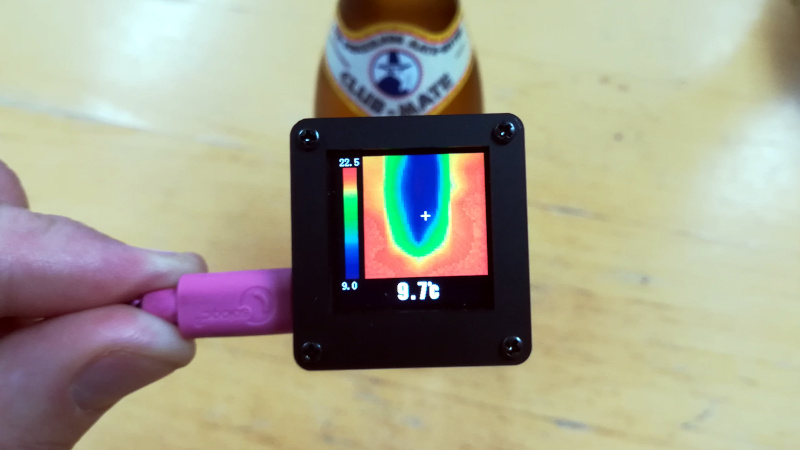
In our ceaseless quest to bring you the best from the cheaper end of the global electronics markets, there are sometimes gadgets that we keep an eye on for a while because when they appear they’re just a little bit too pricey to consider cheap.
Today’s subject is just such a device, it’s a minimalist infra-red camera using the 8 pixel by 8 pixel Panasonic AMG8833 thermal sensor. This part has been around for a while, but even though any camera using it has orders of magnitude less performance than more accomplished models it has remained a little too expensive for a casual purchase. Indeed, these mini cameras were somewhere above £50 ($70) when they first came to our attention, but have now dropped to the point at which they can be found for somewhere over £30 ($42). Thirty quid is cheap enough for a punt on a thermal camera, so off went the order to China and the expected grey parcel duly arrived.
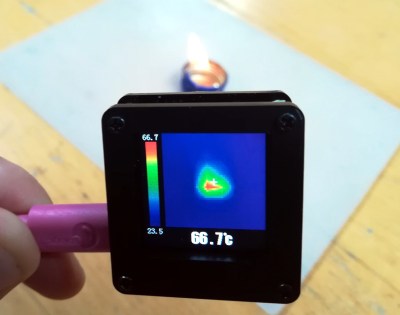
It’s a little unit, 40 mm x 35 mm x 18 mm, constructed of two laser-cut pieces of black plastic held together by brass stand-offs that hold a PCB between them, and on the front is a cut-out for the sensor while on the rear is one for the 35mm OLED display.At the side on the PCB is a micro USB socket which serves only as a power supply. It’s fair to say that this is a tiny unit.
Applying power from a USB battery bank, the screen comes up with a square colour thermal picture and a colour to temperature calibration stripe to its left. The colours adapt to the range of temperatures visible to the sensor, and there is a crosshair in the centre of the picture for which the temperature in Celsius is displayed below the picture. It’s a very straightforward and intuitive interface that requires no instruction, which is handy because the device has none.
There’s something about a thermal camera, that as soon as you have one it is pointed at everything. People appear as red blobs, an extended hand sprouts barely discernible fingers, and a small pool of burning alcohol appears as a bright spot. Pointing it at a powered-up circuit board shows red blobs where each of the chips are, and easily allows low-resolution identification of the hot spots. Enough play though, just how good an instrument is it? A Prusa Mini heated bed makes a handy temperature reference, so it was heated up to 86 degrees for PETG printing and subjected to the camera. It’s a very rough and ready calibration, but the camera read it as 71.2 degrees and an infra-red thermometer at 78.4 degrees. Sadly I don’t have a thermocouple to hand to measure the Prusa directly, but I would be inclined to take any number generated by this camera to be very much on the low side.
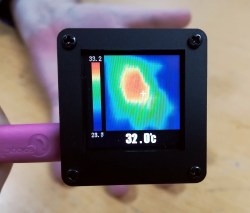
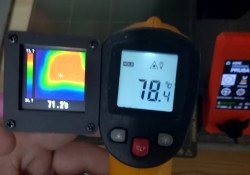
The other use always shown for a thermal camera is to look at a building and see where it is losing heat. Taking the camera out in the night it could certainly see the windows of the house, but on a warm summer evening it probably had less to measure than on a freezing winter night with the heating on. It’s worth noting that the maximum distance it could discern a human at was consistently somewhere around 5 metres.
Having put the camera through its paces it was time to subject it to a teardown. Not an onerous task in this case, simply undo four screws and there’s the PCB. On it is little more than the sensor, the connectors, a microcontroller that defied our identification skills, and a few passives. It’s worth noting that the PCB is milled away between sensor and microcontroller, no doubt to stop thermal contamination. This is an astoundingly simple device.
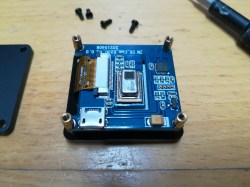
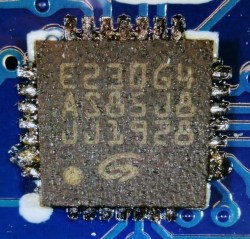
The mini AMG8833 thermal camera then: It’s a functioning thermal camera at a very affordable price. So should you buy it? It’s fairly obvious that when compared to a more expensive thermal camera such as the FLIR Lepton-sporting tCam-Mini we reviewed recently, anything using an AMG8833 is a mere toy. So it’s senseless to berate it for not offering high resolution and other advanced features, because it cost a fraction of the price.
What it does give you is a usable way to evaluate the thermal signature of electronics and other devices, albeit with not entirely trustworthy calibration. It would have been nice to save images or had the USB connection offered some way to retrieve the sensor data, but even without that it delivers on expectations. Yes, it’s a toy, but it’s also a useful toy, and given that you’d probably spend more than the thirty quid it costs building your own version from modules I’d call it a diamond in the rough. I didn’t regret that particular AliExpress order, and I don’t think you will either.
0 Commentaires